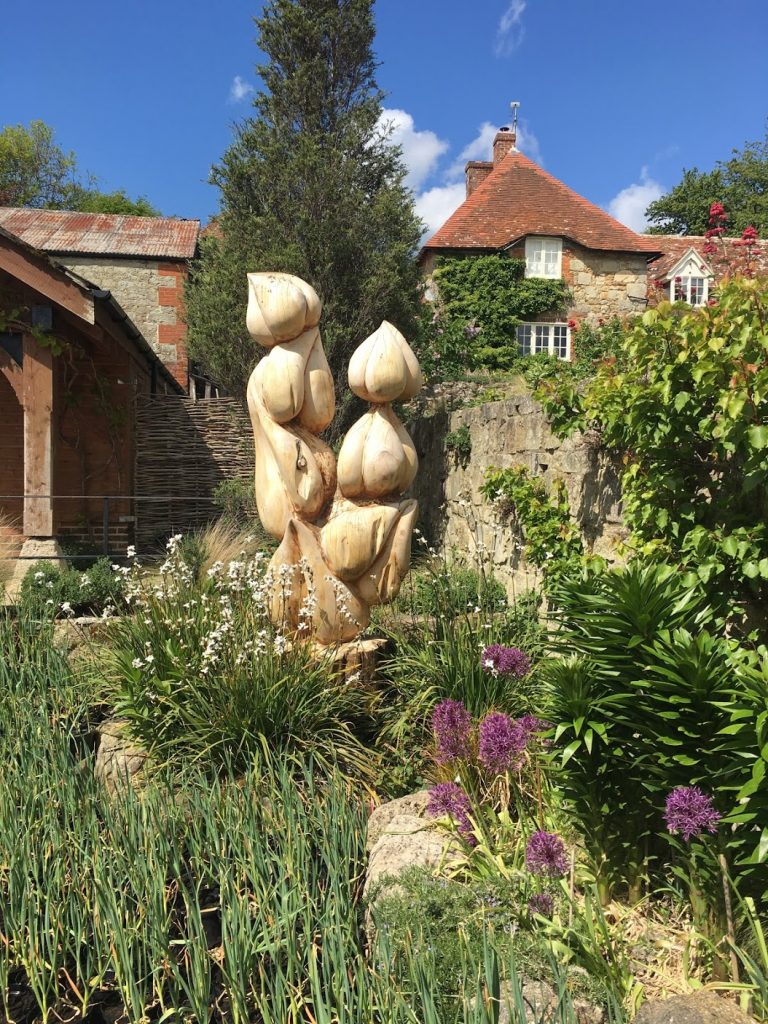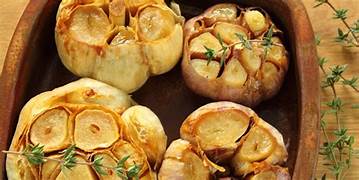“Garlic used as it should be used is the soul, the divine essence, of cookery. The cook who can employ it successfully will be found to possess the delicacy of perception, the accuracy of judgment, and the dexterity of hand which go to the formation of a great artist.” – Mrs. W. G. Waters
As Spring finally arrives, wild garlic has been proliferating all over the Isle of Wight, the multitude of white flowering heads sprinkled thick as snow through woodlands, along the verges and across fields. The National Trust are even using it for wild garlic soup, and apparently the leaves are great in a salad.

I have seen the Garlic Farm mentioned in numerous Isle of Wight publications. Unable to fathom why I would want to visit a farm immersed in the nose-crinkling aroma of garlic, I heard on the grapevine that it has one of the nicest restaurants on the island for lunch. Then I read that it is far more than a mere farm, but a feast of entertainment and education, too. Left to my own devices for a couple of days, while the One & Only trekked up to London, I passed the sign on a quiet country lane and, on a whim, decided to drop in for a visit.
Down the lush green lanes of the Isle of Wight, tucked away from the madding crowd in the glorious Arreton Valley, is a sign on a wall:
‘Stop and smell the garlic – that’s all you have to do’ ~ William Shatner
As I climbed out of the car, my assumptions were proved instantly wrong – there is no strong scent of garlic on the air at all. In the farm yard, old stone farm buildings have been converted into visitor-friendly spaces. There’s the cosy Allium café and a heritage centre that tells the history of the farm and the story of garlic. A large tasting room provides a cornucopia of garlic products, including a couple of unexpectedly spicy (as in achingly hot) offerings. There is even a garlic ice cream, which I may try when the weather is warmer.
Invited to taste the various condiments, I happily wallowed in pickles, chutneys, sauces and jams. Then I walked through the heritage centre and dipped deep into the history of the farm, and the ancient tale of garlic.
Like many foods now common to our tables and our supermarkets, garlic is not a native of England, but travelled west from Central Asia. Closely related to the onion, shallots, leeks and chives, garlic was popular with the Sumerians, and we’re talking three millennia BEFORE Christ. The Ancient Egyptians were aware of its health benefits, in the Talmud, it is believed to be an aphrodisiac. And, of course, it has been at the heart of French culinary culture for centuries. Long held in disdain by the English, we have long mocked our garlic eating neighbours for their strange taste. Today, we know better than to criticize, and English cooking can be grateful for the addition of garlic to a somewhat bland cuisine.
Back on the farm, the Boswell family planted its first garlic crop in 1972 in the kitchen garden. Seeing how well it took to the soil and the climate, Colin Boswell, travelled the world seeking out the history and origins of garlic. Meanwhile, his wife Jenny experimented in the farmhouse kitchen with different garlic varieties in pickles and chutneys. Colin’s travels unearthed some rare and interesting varieties of garlic, many of which are exhibited in a plot below the wildflower meadow. Studying the signs, I discovered that the garlic here comes from as far afield as Japan and China, Uzbekistan and Kazakhstan, Turkey and Siberia, and as close as Italy and Spain. And, not surprisingly, there are several types from regional in France. Today, the Garlic Farm boasts at least fifteen varieties of peripatetic garlic and it has become the UK’s largest specialist garlic grower.
As we all know, garlic has a characteristic pungent, spicy flavor that mellows and sweetens – caramelizes almost -with cooking, particularly if you roast it. Garlic is essential to many cultures, and there are some six hundred varieties to choose from. It is popular across Asia, predominant in Arabic cooking, popular around the Mediterranean. Think hummus, shawarma, tzatziki, aioli…

In a nod to ancient British prejudices, the farm’s blog admits that ‘garlic does make your breath smell and although there are some ways to mitigate the effects, it’s not always possible to remove it completely.’ It seems there is a particular compound in garlic that our bodies find difficult to assimilate. That notoriously scented compound is therefore forced to exit via the breath, pores and perspiration. This may only be a problem for the English – other garlic-loving nations couldn’t seem to care less – but there are ways to reduce the effect on your breath if it bothers you:
• Drink plenty of water, as this will flush it quickly through the system
• Eat a chocolate coated coffee bean – and smell of coffee instead
• Chew on some fresh parsley, mint or apples
• Drink a glass of full cream milk
Do bear in mind that a little bad breath may just be worth the great flavour. After all, is it any worse than coffee or raw onions?
Not only does garlic improve the taste of a wide variety of dishes, but many claim it has medicinal value, too. During World War I – before penicillin – garlic was used as an antiseptic to clean wounds and prevent gangrene. It is commonly believed that garlic consumption can reduce some types of cancer, high blood pressure and blood clots, not to mention deterring vampires. It may improve cholesterol levels and boost the immune system to deter the common cold. Apparently, crushed garlic in warm water will heal mouth ulcers and prevent insomnia. Whether any of this has been proved, I haven’t been able to ascertain, but it is nonetheless heartening, if only as a placebo effect. On another level, garlic is also a natural fungicide that, if grown in tandem with other crops can repel many unwanted visitors such as aphids. Also, garlic, if allowed to flower, will attract bees.
Who would have thought there was so much to learn about garlic? And there’s more…
I also learned that there are two different garlic families: soft-necks and hard-necks. Soft-necks refer to the soft stem and these types do not flower, but produce smaller, tightly-packed cloves, and prefer living closer to the equator. The flowering kind produces a ‘scape’ or ‘rocambole’- a flowering head – that is generally picked off early to maximise the growth of the edible bulb. The scape can also be turned into a culinary treat: sautée it in butter or add it to soups or stews.
Tips on storing garlic include hanging them up in a dry place – do not refrigerate or seal in plastic. And there are methods to plait or ‘grappe’ your garlic cloves so they keep longer – and look prettier!
The Garlic Farm is quite the family business. Daughter Natasha has written two books on cooking with garlic and how to get the most of its amazing health benefits. Daughter Josephine and son Hugo run the Garlic Farm Field Kitchen, a mobile catering service for events, shows and music festivals where garlic is the star turn on the menu.
Fancy a farm holiday? There are six beautiful stone holiday cottages on the property to rent. And in the field above the restaurant, there is a terrific little playground for smaller kids which made me wish I was still three feet high. I followed a walking path through fields of wildflowers, past the pine plantation and into the woods, where I found a nursery: two Highland cows feeding their calves in the shade. I left them in peace to wanderback to the restaurant and shop. There are several options for longer walks which I will explore next time, but I was keen to explore the shop now, and my stomach was calling quite loudly for lunch…
In the extensive farm shop, I collected some terrific garlic products. There is also a wide selection of other Isle of Wight products here, such as cheeses and gins. Then, well-armed with gifts for my friends – and me – I decided it was time for coffee. I found a peaceful spot on the terrace, in the sun, and took the time to sip slowly and enjoy the ambiance and the view. Eventually, I ordered myself a glass of rosé and a bowl of garlic button mushrooms doused in garlic cream, accessorized with a colourful array of baby tomatoes and served with soft, fresh bread and butter. Ingredients have been locally sourced wherever possible, and of course garlic plays a prominent role in the menu.
I also read a great little handbook about growing your own garlic, where I was assured that growing garlic is easy and can be grown year-round in mild climates. In England, many varieties are planted in the autumn and harvested in late spring or early summer. (NB: plant them deep in the ground to keep them cosy and warm over winter. You don’t want them to freeze or they rot or go mouldy.) To save drowning you in detail here, the booklet is available in the shop.
If you need some inspiration for cooking with garlic, indulge in a cookbook. And in the meantime, here are a few simple suggestions :

• cut the top off the garlic bulb, coat the cloves by dribbling olive oil (or other oil-based seasoning) over them, and roast them in an oven. Garlic softens and can be extracted from the cloves by squeezing the (root) end of the bulb, or individually by squeezing one end of the clove. Spread on toast, mixed with freshly diced tomato for a Spanish style bruschetta.
• immature scapes are tender and edible. They are also known as “garlic spears”, “stems”, or “tops”. Scapes generally have a milder taste than the cloves. They are often used in stir frying or sautéed like asparagus.
• garlic leaves are a popular vegetable in many parts of Asia. The leaves are cut, cleaned, and then stir-fried with eggs, meat, or vegetables.
• peeled garlic cloves can be bottled in vinegar and stored in the fridge to create pickled garlic, and garlic infused oil is great to season pasta sauces and salads.
And if you are looking for something different to do in the summer, there is even a Garlic Festival here in August.
*With thanks to Google Pics for the images of the garlic flowers and the roast garlic. The Garlic farm snap is my own.
